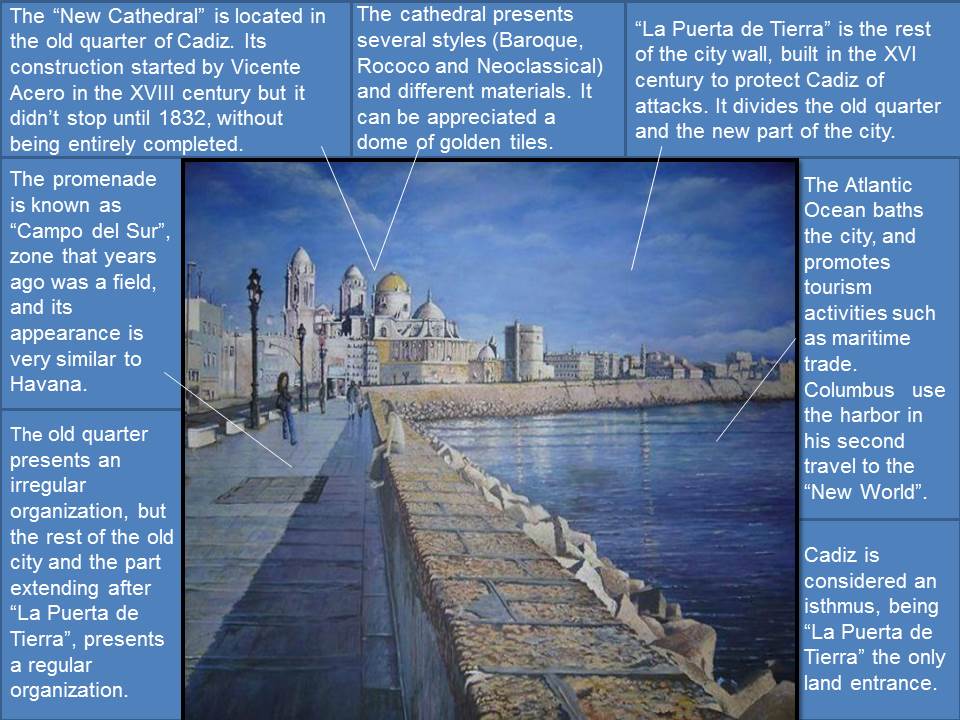This image presents a current view of the cathedral of “Santa Cruz sobre el Mar” in the Spanish city of Cádiz, and it was painted by Juan José Puebla Ronquillo on 24th March on 2009. This city is located in the south of Iberian Peninsula, and it belongs to the Community of Andalucia. It is bathed by the Atlantic Ocean and it is divided in two parts, the “Vendaval” sea, in which the touristic activities are developed; and the Bahía zone, where are developed the commercial and industrial affairs. Cadiz is considered an isthmus because it connects only one side with the rest of the Peninsula.
The urban layout of Cadiz presents a different morphology. It is possible to distinguish an old quarter that presents an irregular organization, in which is located the famous neighborhood called “El Pópulo”, but the rest of the city presents a regular plan. The XX century area extending beyond the «Puerta de Tierra”, presents an orthogonal layout too. The town was surrounded by a city wall built in the end of the XVI century. Its most important gate, that was used as the main entrance to the old quarter, is called “Puerta de Tierra” and divides the city center and the new area. They built the city wall to protect Cadiz against a number wars that happened near around because of its economical importance. Besides, it was necessary to control the entrances of the city for fiscal reasons.
Cádiz is an important city because of its old Phoenician origins, and the cultural footprint of the different people who lived there. As a consequence, there is a lot of monuments, churches, gardens and squares. The main thing we can distinguish in the picture is a promenade known as “Campo del Sur”, that leaves on the left hand the Atlantic Ocean, and it is compared with the «Malecón» from Havana (Cuba). At the top of the image we can appreciate the cathedral of “Santa Cruz sobre las Aguas”, also known as “New Cathedral”. This religious monument is called this way because it is compared with de “Old Cathedral”, which is a smaller temple near around that was ordered to be built by King Alfonso X El Sabio. Nowadays it is very modified and used only as parish church. Taking a closer look on the right hand of the cathedral, we can appreciate the “Puerta de Tierra” limiting the old quarter.
The “New Cathedral” is located in the center of Cadiz, near the sea. Its construction was started by Vicente Acero in the XVIII century, in 1722, but the construction was very slow, and it didn’t stop until 1832, without being entirely completed. The last author that supervised the job was Juan Daura. It was decided to build a new cathedral because the first one was damaged, and they wish to have a remarkable monument. The long length of the construction process, 116 years, brought into play several styles (Baroque, Rococo and Neoclassical above) and different materials.
In conclusion, we can comment that nowadays Cadiz is a city more highlighted for touristic activities than maritime trade. The good climate, the antiquity of its old quarter, and the number of attractions bring a lot of people every year.
Lourdes Rivero Díaz.


Os deseo un buen día: Soy el autor del cuadro al óleo que habeis utilizado para realizar las reseñas de la ciudad de Cadiz. Por cierto, ciudad de una belleza sin igual. Al verlo expuesto en vuestro blog he sufrido una gratísima sorpresa y alegría. Para mí es un honor inmenso el que os hayais fijado en el y os haya servido de modelo para realizar vuestro trabajo. Soy amante incondicional del arte y la cultura, y que un Centro Universitario de la Universidad de Alcalá haga mención de la obra y de mi nombre, es un orgullo del que os estaré agradecido toda mi vida. Muchísimas gracias. Un saludo.
Estimado Juan José. Gracias por tus comentarios. Tu obra nos ha encantado y nos ha servido para conocer más cosas de esa hermosa ciudad.